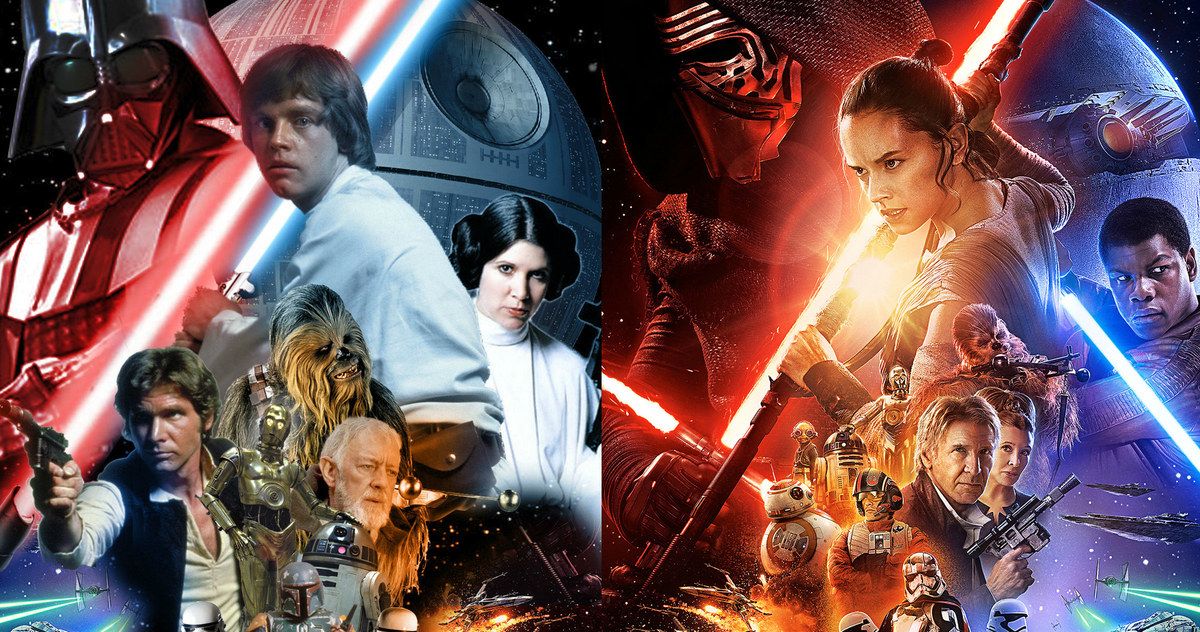While Star Wars: The Force Awakens is the true definition of a box office phenomenon, one that fans and critics both loved, there is a huge problem people have had with the movie since it arrived in theaters this past December. And that's the fact that it is way too similar to Star Wars: Episode IV - A New Hope. Both stories certainly run parallel to each other, and both hit some of the same beats to the minute. Now, a new study shows that the two movies are much more similar than you may have originally thought!
McGill University computer science professor Derek Ruths has taken a deep dive into both movies exclusively for Wired magazine, and you can read their full report here. The study points out the most obvious similarities right off the bat. Both sci-fi adventures follow a desert-dwelling, force sensitive individual who is forced to journey away from their home planet for a life-altering mission. They team up with smugglers, join the Rebellion/Resistance, and help destroy a mammoth weapon capable of destroying entire planets. When you watch both movies back to back, the similarities almost become overwhelming. But Derek Ruths suspected there was something bigger to the whole thing. He states the following.
"I came away with the sense that it felt as though it was the same as A New Hope, but I didn't feel disappointed. That paradox got me thinking."
The professor's study is purely scientific. He just happens to work at the McGill's Network Dynamics Lab, where human behavior is studied. He decided to do character comparison data by scraping the scripts of both movies. He went onto determine the number of scenes in which various characters make an appearance. He then tallied that against how many times any given character interacts with one of the other characters. The resulting data proves that Star Wars: Episode IV - A New Hope and Star Wars: The Force Awakens are basically mirror images of themselves. And many of the characters fall into the same groups. But when mapping out the Star Wars: The Force Awakens characters in comparison to their Star Wars: Episode IV - A New Hope dopplegangers, Derek Ruths didn't get the matches he initially thought he would.
The character mapping actually resulted in some big surprises. Obviously, BB-8 matches R2-D2 in the two films, while Chewbacca maps to himself. And the rebel pilots attacking the Death Star directly correlate with the Resistance Fighters leading an assault on the Starkiller base. Unexpectedly, though, Poe Dameron, who many thought was Han Solo's match, actually maps to Luke. And even more surprising is that Obi-Wan maps to Kylo Ren. The main character in the new movie, Rey, might be the most surprising of all, as she is matched with Darth Vader. Says Derek Ruths about some of these surprising character match-ups.
"Coming away from the movie you have the sense of Rey being Luke and Kylo Ren being the stand-in for Darth Vader. Based on the characteristics of these individuals, we have this notion of who is equivalent to who. The mapping isn't looking at attributes, it's looking at who interacts with who. So we get a different retelling of that story."
Derek Ruths created two 'spring layouts' for each movie, which show nodes representing each character and who they most often interact with, or don't share any screen time with. The professor first created the Star Wars: Episode IV - A New Hope layout then made the Star Wars: The Force Awakens layout by swapping in corresponding characters.
It's no big revelation that Star Wars: The Force Awakens takes the main personality traits of the characters seen in Star Wars: Episode IV - A New Hope and shuffles them around. Poe takes on Luke's piloting abilities, and he is now the leader of his X-Wing squadron. Rey and Kylo Ren's duel mirrors that of Obi-Wan and Darth Vader. This study hints that Rey may have more in line with Darth Vader's backstory than she does Luke Skywalker. This is especially interesting, since her lineage is one of the most debated Star Wars topics as of late.
Derek Ruths notes that this study is in no way predictive, and he doesn't want to imply that Rey is heading towards the Dark Side. And the study might not be completely accurate, as the mapping pairs Han Solo with Lor San Tekka, while Finn maps to Luke's Aunt Beru. But this analysis does allow for a new way to look at the two movies side-by-side. And it may explain why some of the new characters resonate more than others. To see the spring layouts go here.

